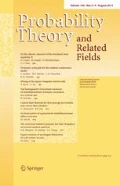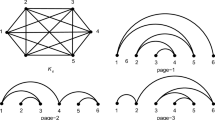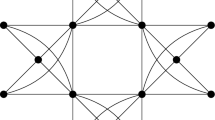Abstract
For a fixed degree sequence \({\mathcal {D}}=(d_1,\ldots ,d_n)\), let \(G({\mathcal {D}})\) be a uniformly chosen (simple) graph on \(\{1,\ldots ,n\}\) where the vertex i has degree \(d_i\). In this paper we determine whether \(G({\mathcal {D}})\) has a giant component with high probability, essentially imposing no conditions on \({\mathcal {D}}\). We simply insist that the sum of the degrees in \({\mathcal {D}}\) which are not 2 is at least \(\lambda (n)\) for some function \(\lambda \) going to infinity with n. This is a relatively minor technical condition, and when \({\mathcal {D}}\) does not satisfy it, both the probability that \(G({\mathcal {D}})\) has a giant component and the probability that \(G({\mathcal {D}})\) has no giant component are bounded away from 1.

Similar content being viewed by others
Notes
A degree sequence is feasible if there is a graph with the given degree sequence.
A component is cyclic if it is a cycle and non-cyclic if it is not.
Here and throughout the paper, when we say we suppress a vertex u of degree 2, this means we delete u and we add an edge between its neighbours. Observe that this may create loops and multiple edges, so the resulting object might not be a simple graph.
As it is standard, we use order and size to denote the number of vertices and the number of edges of a graph, respectively.
Note that some of these results give a more precise description on the order of the largest component. Our results only deal with the existential question.
Their result gives convergence in probability of the proportion of vertices in the giant component and they also consider the case \(Q(\mathfrak {D})=0\).
They also proved some results on the distribution of the order of the largest component and also consider the case \(Q(\mathfrak {D})=0\).
Observe that \(X_\ell \) follows a hypergeometric distribution.
In fact, the Molloy–Reed result does not discuss the case \(Q(\mathfrak {D})=0\).
References
Aiello, W., Chung, F., Lu, L.: A random graph model for massive graphs. In: Proceedings of the Thirty-Second Annual ACM Symposium on Theory of Computing (STOC). ACM, pp. 171–180 (2000)
Albert, R., Barabási, A.-L.: Statistical mechanics of complex networks. Rev. Mod. Phys. 74, 47 (2002)
Barabási, A.-L., Albert, R.: Emergence of scaling in random networks. Science 286(5439), 509–512 (1999)
Boccaletti, S., Latora, V., Moreno, Y., Chavez, M., Hwang, D.-U.: Complex networks: structure and dynamics. Phys. Rep. 424, 175–308 (2006)
Bollobás, B., Riordan, O.: An old approach to the giant component problem. J. Comb. Theory Ser. B 113, 236–260 (2015)
Bourassa, V., Holt, F.: SWAN: small-world wide area networks. In: Proceedings of International Conference on Advances in Infrastructures (SSGRR 2003w), L’Aquila, Italy (2003)
Cooper, C.: The cores of random hypergraphs with a given degree sequence. Random Struct. Algorithms 25, 353–375 (2004)
Cooper, C., Dyer, M., Greenhill, C.: Sampling regular graphs and a peer-to-peer network. Comb. Probab. Comput. 16, 557–593 (2007)
Faloutsos, M., Faloutsos, P., Faloutsos, C.: On power-law relationships of the internet topology. ACM SIGCOMM Comput. Commun. Rev. 29, 251–262 (1999)
Fernholz, D., Ramachandran, V.: Cores and connectivity in sparse random graphs. Technical report TR-04-13, The University of Texas at Austin, Department of Computer Sciences (2004)
Fernholz, D., Ramachandran, V.: The diameter of sparse random graphs. Random Struct. Algorithms 31, 482–516 (2007)
Flajolet, P., Sedgewick, R.: Analytic Combinatorics. Cambridge University Press, Cambridge (2009)
Fountoulakis, N.: Percolation on sparse random graphs with given degree sequence. Internet Math. 4, 329–356 (2007)
Fountoulakis, N., Reed, B.: A general critical condition for the emergence of a giant component in random graphs with given degrees. Electron. Notes Discrete Math. 34, 639–645 (2009)
Greenhill, C.: The switch Markov chain for sampling irregular graphs. In: Proceedings of the Twenty-Sixth Annual ACM-SIAM Symposium on Discrete Algorithms, pp. 1564–1572. SIAM (2015)
Hatami, H., Molloy, M.: The scaling window for a random graph with a given degree sequence. Random Struct. Algorithms 41, 99–123 (2012)
Janson, S.: On percolation in random graphs with given vertex degrees. Electron. J. Probab. 14, 87–118 (2009)
Janson, S., Luczak, M.J.: A new approach to the giant component problem. Random Struct. Algorithms 34, 197–216 (2009)
Janson, S., Luczak, M.J.: A simple solution to the k-core problem. Random Struct. Algorithms 30, 50–62 (2007)
Joseph, A.: The component sizes of a critical random graph with pre-described degree sequence. Ann. Appl. Probab. 24, 2560–2594 (2014)
Kang, M., Seierstad, T.G.: The critical phase for random graphs with a given degree sequence. Comb. Probab. Comput. 17, 67–86 (2008)
Luczak, T.: Sparse random graphs with a given degree sequence. In: Proceedings of the Symposium on Random Graphs, Poznan, pp. 165–182 (1989)
McKay, B.D.: Subgraphs of random graphs with specified degrees. Congr. Numer. 33, 213–223 (1981)
Molloy, M., Reed, B.: A critical point for random graphs with a given degree sequence. Random Struct. Algorithms 6, 161–180 (1995)
Molloy, M., Reed, B.: The size of the giant component of a random graph with a given degree sequence. Comb. Probab. Comput. 7, 295–305 (1998)
Molloy, M., Reed, B.: Graph Colouring and the Probabilistic Method, vol. 23. Springer, Berlin (2013)
Newman, M.E.J.: The structure and function of complex networks. SIAM Rev. 45, 167–256 (2003)
Newman, M.E.J., Watts, D.J., Strogatz, S.H.: Random graph models of social networks. Proc. Natl. Acad. Sci. 99(Suppl 1), 2566–2572 (2002)
Petersen, J.: Die Theorie der regulären graphs. Acta Math. 15, 193–220 (1891)
Riordan, O.: The phase transition in the configuration model. Comb. Probab. Comput. 21, 265–299 (2012)
van den Esker, H., van der Hofstad, R., Hooghiemstra, G., Znamenski, D.: Distances in random graphs with infinite mean degrees. Extremes 8(3), 111–141 (2005)
van der Hofstad, R., Hooghiemstra, G., van Mieghem, P.: Distances in random graphs with finite variance degrees. Random Struct. Algorithms 27, 76–123 (2005)
Wormald, N.C.: Some problems in the enumeration of labelled graphs. Doctoral thesis (1980)
Wormald, N.C.: Models of random regular graphs, Surveys in combinatorics (Canterbury). London Mathematical Society Lecture Note Series, vol. 267, pp. 239–298. Cambridge University Press, Cambridge (1999)
Author information
Authors and Affiliations
Corresponding author
Additional information
Felix Joos was supported by the EPSRC, Grant No. EP/M009408/1.
Guillem Perarnau was supported by the European Research Council, ERC Grant Agreement No. 306349.
Rights and permissions
About this article
Cite this article
Joos, F., Perarnau, G., Rautenbach, D. et al. How to determine if a random graph with a fixed degree sequence has a giant component. Probab. Theory Relat. Fields 170, 263–310 (2018). https://doi.org/10.1007/s00440-017-0757-1
Received:
Published:
Issue Date:
DOI: https://doi.org/10.1007/s00440-017-0757-1




